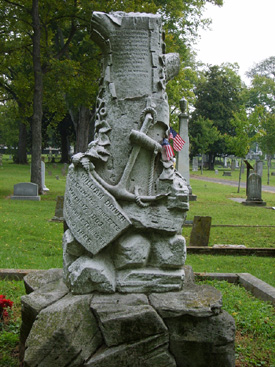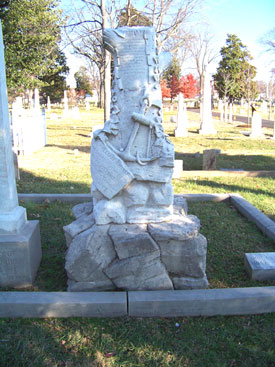|
Driver, Captain William Section 20 ID # 200116 A Master Mariner William Driver Trust in the Lord and do good Documentation
Old Glory 175th Anniversary Stamp Issue REFERENCE INFORMATION |
 enlarge image After 2009 Restoration |
|
William Driver “Old Glory” is a word commonly used today to identify the flag of the United States, but it is a term that originated with a Nashvillian named William Driver, and its popularity began with Nashville’s Civil War history. Driver was a thirty-four year old widower and former merchant sea captain when he arrived in Nashville from Salem, Massachusetts, in December 1837. He brought with him his three young children and he also brought his cherished United States flag, which he had named “Old Glory.” It had been made by his mother and the “girls of Salem,” and presented to him on his twenty-first birthday. In Nashville Driver planned to go into business with his brothers. He re-married, had nine additional children, and settled with his family at present-day 511 Fifth Avenue South. On special occasions, such as election days and the Fourth of July, he would display “Old Glory” from a rope which hung across the street. The flag became a familiar sight. When Civil War came to America in 1861 Tennessee moved to join the Confederacy. But Driver remained loyal to the Union, and he hid “Old Glory” to protect it. Driver’s Nashville family did not share his Union allegiance, and one of his sons died for the Confederacy. On February 25, 1862, the Union Army captured Nashville, which was the first Confederate state capital to be re-claimed. Driver brought “Old Glory” out of hiding, and it was raised over the Tennessee Capitol. News of the loyal Union man and his cherished flag spread throughout the North, and “Old Glory” eventually became an American icon. Driver lived in Nashville until his death in 1886, but his flag lived on. He had given it to his daughter in 1873, and she donated it to President Warren G. Harding in 1922. Today it resides at the Smithsonian Institution. When Driver died he was buried in the Nashville City Cemetery, marked by a monument of his own design. The monument features a broken tree trunk and an anchor, along with the inscription, “His Ship, His Country, and his flag, Old Glory.” |
|
|
|
|

